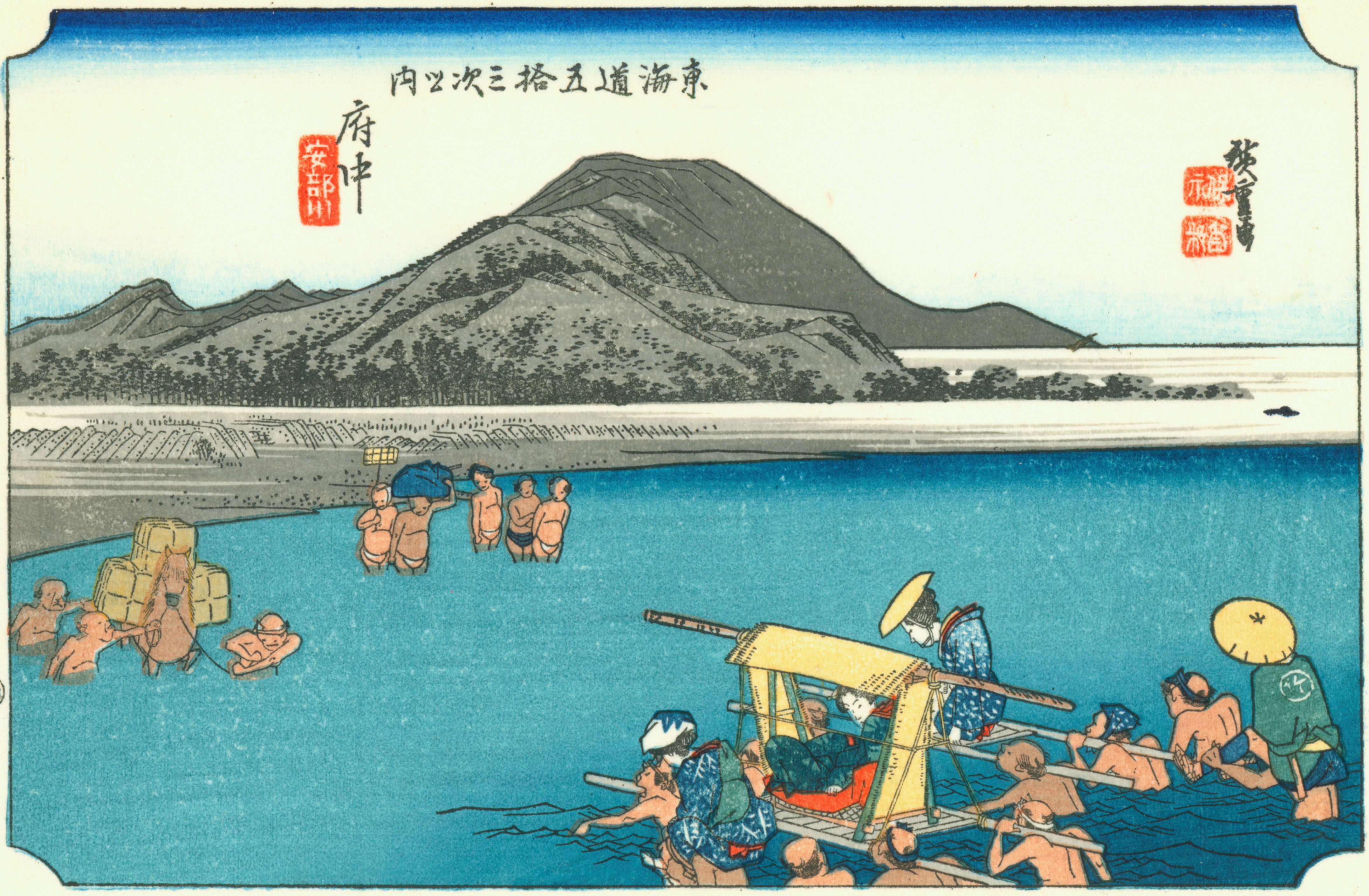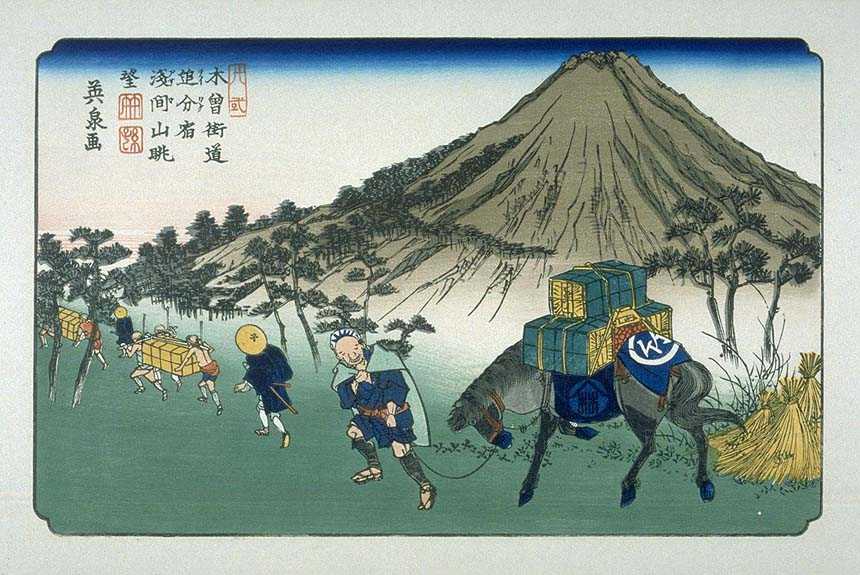|
Fuchū-shuku
was the nineteenth of the fifty-three stations of the Tōkaidō. It is located in what is now part of the Aoi-ku area of Shizuoka, Shizuoka Prefecture, Japan. History The post station of Fuchū-juku was also a castle town for Sunpu Castle in the former Suruga Province.Fuchū-juku to Mariko-juku Tōkaidō Hitoritabi. Accessed December 7, 2007.  The classic print by
The classic print by
|
53 Stations Of The Tōkaidō
The are the rest areas along the Tōkaidō (road), Tōkaidō, which was a coastal route that ran from Nihonbashi in Edo (modern-day Tokyo) to Sanjō Ōhashi in Kyoto.. There were originally 53 government shukuba, post stations along the Tōkaidō, where travelers had to present traveling permits at each station if wanting to cross. In 1619, the Ōsaka Kaidō (大阪街道) was developed to extend the Tōkaidō so that it would reach Kōraibashi in modern-day Osaka. Instead of going to Sanjō Ōhashi, travelers would leave from Ōtsu-juku and travel towards Fushimi-juku (Tōkaidō), Fushimi-juku. Because of the addition of these four post towns, the Tōkaidō is occasionally referred to as having 57 stations. Another name for this extension was Kyōkaidō (京街道). The inland Nakasendō also started at Nihonbashi, and converged with the Tōkaidō at Kusatsu-juku. Shio no Michi intersected with the Tōkaidō at Okazaki-shuku. Stations of the Tōkaidō File:NihombashiDat ... [...More Info...] [...Related Items...] OR: [Wikipedia] [Google] [Baidu] |
Mariko-juku
was the twentieth of the fifty-three stations of the Tōkaidō. It is located in what is now part of Suruga Ward in Shizuoka City, Shizuoka Prefecture, Japan. It can also be written as 丸子宿 (''Mariko-juku''). History Mariko-juku was one of the smallest post stations on the Tōkaidō.Mariko-juku . www.uchiyama.info. Accessed December 19, 2007. Old row-houses from the can be found between Mariko-juku and Okabe-juku, its neighboring post station, in Utsuinotani. This post town also had strong ties to the Minamoto, [...More Info...] [...Related Items...] OR: [Wikipedia] [Google] [Baidu] |
Ejiri-juku
was the eighteenth of the 53 Stations of the Tōkaidō, fifty-three stations of the Tōkaidō (road), Tōkaidō. It is one of four former shukuba, post stations located in what is now part of the Shimizu-ku, Shizuoka, Shimizu-ku area of Shizuoka, Shizuoka, Shizuoka, Shizuoka Prefecture, Japan. It was 3.4 kilometers from Okitsu-juku, the preceding post station. History Ejiri-juku was Ejiri Castle's castle town. The castle was built in 1570, but Ejiri-juku was not officially designated a post station until the early 17th century. At its peak, it had two ''honjin'', three sub-''honjin'' and 50 ''hatago'', among the 1,340 total buildings. Its population was around 6,500.53 Stations of the Tōkaidō - Ejiri-juku . Kōhei Wada. Accessed November 9, 2007. Ejiri-juku gave its name to the area's railway station, unt ... [...More Info...] [...Related Items...] OR: [Wikipedia] [Google] [Baidu] |
Kago
A is a type of litter used as a means of human transportation by the non-samurai class in feudal Japan and into the Meiji period The was an era of Japanese history that extended from October 23, 1868, to July 30, 1912. The Meiji era was the first half of the Empire of Japan, when the Japanese people moved from being an isolated feudal society at risk of colonizatio ... (1868–1911). Description and use The basket of a was roughly long, and attached to bamboo uprights which were suspended by a large overhead single crossbeam. A roof of some type covered the top and screens could be used to cover the sides as protection from sun or rain. A would be carried by a team of four men, who would take turns carrying the on their shoulders; five or six miles could be traveled in one hour. One man would support the weight of the large overhead pole at each end and walked until he tired and switched with a rested carrier. The should not be confused with the more elaborate ... [...More Info...] [...Related Items...] OR: [Wikipedia] [Google] [Baidu] |
Abe River
The is a Class A river in Shizuoka Prefecture in central Japan. It is long and has a drainage basin of . Approximately 170,000 people live in the basin area. The river rises in the Akaishi Mountains, which stretch over the boundary between Yamanashi and Shizuoka Prefectures, and flows into Suruga Bay in the Pacific Ocean. It is known for its clear stream and forms part of the main water supply for Shizuoka city. There are many hot springs at the river head, which is also known for its numerous landslides and for the Abe Great Falls, one of Japan's Top 100 Waterfalls. Unlike the nearby Tenryū River and Ōi River, there are no dams on the Abe River. Tokugawa Ieyasu carried out extensive construction and formed the present route of the lower course of the river. , a ''mochi'' rice cake dusted with kinako ( soybean flour), has been a local speciality of this area since at least the Edo period The , also known as the , is the period between 1600 or 1603 and 1868 in the ... [...More Info...] [...Related Items...] OR: [Wikipedia] [Google] [Baidu] |
Andō Hiroshige
or , born Andō Tokutarō (; 1797 – 12 October 1858), was a Japanese ''ukiyo-e'' artist, considered the last great master of that tradition. Hiroshige is best known for his horizontal-format landscape series '' The Fifty-three Stations of the Tōkaidō'' and for his vertical-format landscape series '' One Hundred Famous Views of Edo''. The subjects of his work were atypical of the ''ukiyo-e'' genre, whose typical focus was on beautiful women, popular actors, and other scenes of the urban pleasure districts of Japan's Edo period (1603–1868). The popular series '' Thirty-six Views of Mount Fuji'' by Hokusai was a strong influence on Hiroshige's choice of subject, though Hiroshige's approach was more poetic and ambient than Hokusai's bolder, more formal prints. Subtle use of color was essential in Hiroshige's prints, often printed with multiple impressions in the same area and with extensive use of '' bokashi'' (color gradation), both of which were rather labor-intensive ... [...More Info...] [...Related Items...] OR: [Wikipedia] [Google] [Baidu] |
Ukiyo-e
is a genre of Japanese art that flourished from the 17th through 19th centuries. Its artists produced woodblock printing, woodblock prints and Nikuhitsu-ga, paintings of such subjects as female beauties; kabuki actors and sumo wrestlers; scenes from history and folk tales; travel scenes and landscapes; Flora of Japan, flora and Wildlife of Japan#Fauna, fauna; and Shunga, erotica. In 1603, the city of Edo (Tokyo), Edo (Tokyo) became the seat of the ruling Tokugawa shogunate. The class (merchants, craftsmen and workers), positioned at the bottom of Four occupations, the social order, benefited the most from the city's rapid economic growth. They began to indulge in and patronize the entertainment of kabuki theatre, geisha, and oiran, courtesans of the Yūkaku, pleasure districts. The term ('floating world') came to describe this hedonistic lifestyle. Printed or painted ukiyo-e works were popular with the class, who had become wealthy enough to afford to decorate their homes wit ... [...More Info...] [...Related Items...] OR: [Wikipedia] [Google] [Baidu] |
Sunpu Castle Tatsumiyagura , officials of the Tokugawa shogunate during the Edo period Japan
{{disambiguation, geo ...
Sunpu or Sumpu may refer to: *The former name of Shizuoka, Shizuoka, Japan *Sunpu Domain, a Japanese feudal domain during the Edo period centered in Suruga Province *Sunpu Castle, a former castle in Shizuoka City, Shizuoka Prefecture, Japan *Sunpu jōdai were officials of the Tokugawa shogunate with responsibility for holding and defending Sunpu Castle (Sunpu''-jō''), also called Shizuoka Castle. Appointments to the prominent office of castle warden at Sunpu Domain were exclusively ''fudai da ... [...More Info...] [...Related Items...] OR: [Wikipedia] [Google] [Baidu] |
Suruga Province
was an Provinces of Japan, old province in the area that is today the central part of Shizuoka Prefecture. Suruga bordered on Izu Province, Izu, Kai Province, Kai, Sagami Province, Sagami, Shinano Province, Shinano, and Tōtōmi Province, Tōtōmi provinces; and was bordered by the Pacific Ocean through Suruga Bay to the south. Its abbreviated form name was . History Early period Suruga was one of the original provinces of Japan established in the Nara period under the Taihō Code. The original capital of the province was located in what is now Numazu, Shizuoka, Numazu, which also had the provincial temple, ''Kokubun-ji'' and the Ichinomiya (Mishima Taisha) of the province. Under the ''Engishiki'' classification system, Suruga was ranked as a "major country" (上国), and was governed by a ''Kuni no miyatsuko'' ; under the ''ritsuryō'' system, Suruga was classified as a "middle country" (中国). In a 680 AD cadastral reform, the districts forming Izu Province were administrat ... [...More Info...] [...Related Items...] OR: [Wikipedia] [Google] [Baidu] |
Sunpu Castle
is a Japanese castle in Shizuoka City, Shizuoka Prefecture in Japan. The sobriquet of this feudal fortress was the "Castle of the Floating Isle".Japan Society for the Promotion of Science (JSPS)Shizuoka It was also referred to as or . History During the Muromachi period, the Imagawa clan ruled Suruga Province from their base at Sunpu (modern-day Shizuoka City). It is not certain exactly when an Imagawa Sunpu castle was built on this site. Tokugawa Ieyasu After Imagawa Yoshimoto was defeated at the Battle of Okehazama in 1560, Suruga Province passed to the Takeda clan, and then to Tokugawa Ieyasu, who had spent his youth in Sunpu as Yoshimoto's hostage. In 1585, Ieyasu constructed a new Sunpu Castle on the approximate site of the former fortified Imagawa residence. He took up residence at the castle in 1586, along with his favored consort, Lady Saigō, and their two sons, Hidetada and Tadayoshi.Kobayashi and Makino (1994), p.400. Lady Saigo died at Sunpu Castle in 15 ... [...More Info...] [...Related Items...] OR: [Wikipedia] [Google] [Baidu] |
Shukuba
were Stage station, staging post stations during the Edo period in Japan, generally located on one of the Edo Five Routes or one of its sub-routes. They were also called ''shuku-eki'' (宿駅). These stage stations, or "" developed around them, were places where travelers could rest on their journey around the nation. They were created based on policies for the transportation of goods by horseback that were developed during the Nara period, Nara and Heian period, Heian periods. History These stations were first established by Tokugawa Ieyasu shortly after the end of the Battle of Sekigahara. The first stations were developed along the Tōkaidō (road), Tōkaidō (followed by stations on the Nakasendō and other routes). In 1601, the first of the Tōkaidō's 53 Stations of the Tōkaidō, fifty-three stations were developed, stretching from Shinagawa-juku in Edo to Ōtsu-juku in Ōmi Province. Not all the post stations were built at the same time, however, as the last one was bui ... [...More Info...] [...Related Items...] OR: [Wikipedia] [Google] [Baidu] |







